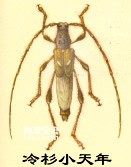The beetles we see usually have their elytra covering the entire abdomen, but there are also a few beetles whose elytra are very short and only cover the front 1-2 segments of the abdomen. The fir beetle is one of the three.
The body is small, body length: 7.5-10.5 mm, body width: 2-2.5 mm. The body is black, the antennae, elytra and legs are reddish brown, the back is covered with long light brown loose hairs, and the hairs on the front and rear edges of the chest and back, the small scutes and the ventral surface are silvery white. The head is as wide as the front end of the prothorax, with small dots; the forehead is flat, with a shallow longitudinal groove between the antennae. The antennae are long, and the female's antennae are about the same length as the body or slightly longer, with 11 segments; the male's antennae are twice as long as the body, with 12 segments. The prothorax is longer than wide, and the rear end is slightly narrower than the front end. The rear end is compressed in front and has a transverse groove. The lateral spines are small and blunt. The dorsal plate of the prothorax is densely carved and slightly wrinkled, and there are 5 microorganisms in the middle region. There are circular ridges with carved dots, two on both sides are larger, and one in the middle is waterier. The scutes are slightly rectangular with rounded ends. The elytra are shortened, reaching the center of the first abdominal segment. The base end is wide, the end is narrow, the trailing edge is rounded, the end of the wing is thicker and raised; the points on the wing surface are large and sparse, and there is a milky white longitudinal stripe diagonally extending slightly behind the center. Towards the rear, the sides are symmetrical and form an inverted figure eight. The foot is thin, and the end of the leg segment suddenly swells.

Host plant: fir.
Distributed in Northeast my country, southern Shaanxi, Siberia, North Korea, Japan and Europe.
Living habits: One generation occurs every year, overwintering as larvae. Adult insects appear in large numbers from early June to mid-July each year and fly in the air. The larvae feed in the trunks or branches of newly cut pine and fir trees. The larvae have long and curved passages that penetrate deep into the xylem.
animal tags:
We created this article in conjunction with AI technology, then made sure it was fact-checked and edited by a Animals Top editor.